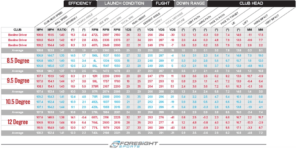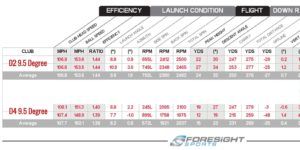
Everyone loves their driver. It’s the single most important product in the golfing world for two reasons:
- It costs the most amount of money for a single club
- It hits the ball the farthest
This is exactly why most of the major manufacturers spend a large chunk of their marketing dollars touting the effectiveness of their respective drivers. As such, consumers are led to believe certain ones are going to be the fix for their game.
Taylor Made recently launched a massive campaign for their M1 driver, and it generated a tremendous amount of hype. The ‘Unmetal Wood’ certainly had a ton of mystique surrounding it, and it quickly became the best-selling driver on the market.
I’m sure plenty of golfers got on Taylor Made’s website, or went to their local retailer as soon as it was available, and shelled out $499 for it. They all might have missed an important step though.
Was it the right loft for them? Did they get the right shaft flex, or length? Was there another manufacturer’s club that might have produced better results for their particular swing?
The problem is that you can’t know for sure until you sit down with a knowledgeable club fitter, and test these variables. To me, if you’re going to invest that much money in a golf club, it better be the right one!
I recently went back to my friends at Pete’s Golf to discuss driver fittings, and to do an informal test between a couple of models just to see how different my results might be by changing lofts and driver heads.
My goal is to educate you on the key variables when selecting a driver, and why simply choosing one brand over another because of marketing claims might be a mistake.
Thoughts from an expert
I did my testing with Woody Lashen, who is the co-owner of Pete’s Golf shop in Mineola, NY. Last month I did my test of the PXG irons with him, and he was kind enough to lend me some of his time to discuss drivers. If you happen to live in the New York Metro region you should think about seeing him, Pete, or Kirk about a club fitting. They will give you the straight story, and get the right clubs for your game without any gimmicks or sales tactics.
The first thing I asked Woody was to rank the most important factors of a driver fitting. After doing thousands of fittings for more than three decades, he believes they are:
- Head – Loft/Manufacturer
- Shaft - Profile, Flex and Weight
- Shaft Length and Club Balance
Getting a mixture of these three factors correct takes the keen eye of a fitter who can evaluate your numbers, but more importantly your swing.
If you just go to the store and pick out a driver without having these three key variables evaluated, you are taking a shot in the dark with your hard-earned money.
Choosing incorrectly might leave you with a driver setup that is completely wrong for your game, and you’ll be fighting against your equipment rather than having your swing enhanced by it.
As a caveat, I always believe that the golfer is the one responsible for putting a good swing on the club, but you want to give yourself the best chance at success.
Related Article: Find out why swing speed is not enough to choose a stiff vs regular flex shaft.
My Informal Test
The reason I wanted to test out drivers with Woody was not to establish that one particular driver is better than another. I wanted to show that changing just one of these key variables could produce dramatic differences in shot performance.
Hopefully by seeing my results you will think twice about just assuming an off-the-shelf driver is the right one for you.
The main variable in our testing was the loft and type of driver head. We kept the shaft length and flex almost exactly the same.
First up was the Taylor Made M1. I tried heads with 8.5, 9.5, 10.5, and 12.0 degrees of loft. We did not make any adjustments to the weighting (which can open up another huge can of worms by the way). We also used my current driver, a Callaway Razr Fit Tour Authentic 9.5 degree, as the baseline.
Here is the data:

Right off the bat, the 8.5 degree did not work out for me. You might assume that with a swing speed of around 110 mph that a lower loft would be better for me, but my spin rates were dangerously low. Woody said that his Foresight system could not accurately predict the distance at spin rates lower than 2000, but guessed that I wouldn’t have flown the ball more than 230 yards because the loft was way too low for me (what you see in the data is a little exaggerated).
Part of the reason was because I had struck the ball very high on the face of the 8.5. We can’t know for sure if that was because of me, or the actual club. However, Woody had to take that into consideration when deciding which loft was going to be the right one overall.
Based on my results with the rest of the lofts, he concluded that the 10.5 degree offered the best combination of spin rate, distance, and control for my particular swing. This was actually a big surprise to me. I was expecting to be getting better performance from a lower loft.
As a side note, the M1 did not significantly outperform my current Callaway driver which is 4 years old at this point. So had I been in the market to buy this particular club, it might have been not been the best decision. That’s not to say that the M1 might not improve your performance over your current driver, but I think you see the point I am trying to get at.
Titleist D2 vs D4
Next up we tried making changes to the type of head, but keeping the loft the same.
We tested a Titleist D2 versus a D4, here is the data:

Both versions were not going nearly as far as my current driver or the M1, so there was a big difference there.
The D4 was not flying nearly as high or far as the D2, and there was a significant gap in distance between the two with the same loft of 9.5.
With just a couple of heads and a few changes, we were able to produce all different kinds of shots. Many of them were undesirable.
Moral of the story
This test only had a few variables with the driver head, and we came up with completely different results. Imagine if we threw shaft flex and length into the mix?
The point I am trying to make here is that someone who knows what they are doing can help make the right decision. If you just show up to the store and pick out an 11 degree Ping driver with a regular shaft, you might be leaving a ton of distance and accuracy on the table.
All drivers are not made the same, and all golfers have different swings. One club might be better for you than another, despite whatever marketing claims you have seen.
For an hour of your time and little extra money, you can make sure you are giving yourself the best chance off the tee with the right driver setup.
Get fitted!
Bonus Content - if you want to learn how to maximize your driver distance please check out my complete guide here.
We care about the protection of your data Read our Privacy Policy